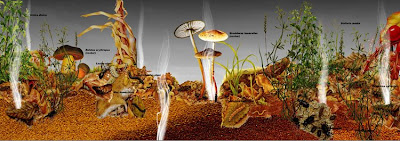Joyce van den Berg, a Dutch landscape architect, has some interesting plans to memorialize the thin strip of land that divided East and West Germany. From Spiegel Online: “The “death strip” or No Man’s Land was the ground between the two Germanys. In the inner city the border consisted of an actual concrete wall, the one most commonly recognized as the Berlin Wall, but around the outer edges of the city the border was marked mainly by fences, watch towers and an empty strip of “No Man’s Land.” There are around 155 kilometers (96 miles) of the former border strip measuring between 20 meters and 2.5 kilometers in diameter.”

:: image via Speigel Online
More: “Van den Berg, who carefully researched exactly where the former border used to be, also has some ideas for the man-made remnants at the former border. At one stage there were 302 watch towers on the border; today only five still exist. Van den Berg would like to see the five remaining towers, and any others that can be resurrected, turned into small, secret gardens. Unusual plants could be nurtured inside, protected from the wind and elements and onlookers wouldn’t even realize the watch towers were there until they came closer, she says.”

:: image via Speigel Online
The idea of restoration is essential to the scheme: “Her plan would see the barren strips of sand moved at regular intervals in order to encourage new plant life to take root as well as the ongoing formation of the “mega-dunes” that are already evolving naturally in the German woods.”
Equally compelling are the graphics depicting some of this process landscape of revitalizing the sandy substrate.

:: images via Speigel Online
More: “Van den Berg also has a cunning scheme to mark the hidden escape tunnels that once led from east to west. These are considered some of the meaningful remnants of the former border area because if the tunnels, constructed at great risk to the tunnellers, were discovered it would often mean a shift in the border on the East German side, sometimes even the demolition of entire buildings or blocks. To mark where the tunnels were, van den Berg suggest beams of light be shone from the West toward the East, commemorating both the tunnels and all those who tried to use them.”

:: images via Speigel Online

